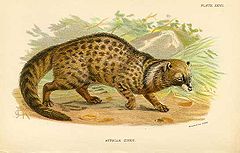Wiwery
podrodzina ssaków z rodziny wiwerowatych
Wiwery[17] (Viverrinae) – podrodzina drapieżnych ssaków z rodziny wiwerowatych (Viverridae).
| Viverrinae | |||||
| J.E. Gray, 1821[1] | |||||
 Przedstawiciel podrodziny – cyweta afrykańska (Civettictis civetta) | |||||
| Systematyka | |||||
| Domena | |||||
|---|---|---|---|---|---|
| Królestwo | |||||
| Typ | |||||
| Podtyp | |||||
| Gromada | |||||
| Podgromada | |||||
| Infragromada | |||||
| Rząd | |||||
| Podrząd | |||||
| Infrarząd | |||||
| Rodzina | |||||
| Podrodzina |
wiwery | ||||
| Typ nomenklatoryczny | |||||
|
Viverra Linnaeus, 1758 | |||||
| |||||
| Rodzaje | |||||
| |||||
Zasięg występowania
edytujPodrodzina obejmuje gatunki występujące w Afryce oraz południowej i południowo-wschodniej Azji[18][19][20]:
Systematyka
edytujDo podrodziny należą następujące występujące współcześnie rodzaje[17][18][21]:
- Viverricula Hodgson, 1838 – wiwerka – jedynym przedstawicielem jest Viverricula indica (É. Geoffroy Saint-Hilaire, 1803) – wiwerka malajska
- Civettictis Pocock, 1915 – cyweta – jedynym występującym współcześnie przedstawicielem jest Civettictis civetta (von Schreber, 1776) – cyweta afrykańska
- Viverra Linnaeus, 1758 – wiwera
Opisano również rodzaje wymarłe[22]:
- Megaviverra Qiu Zhanxiang, 1980[23]
- Vishnuictis Pilgrim, 1932[24]
- Viverrictis Beaumont, 1973[25]
Uwagi
edytujPrzypisy
edytuj- ↑ a b J.E. Gray. On the Natural Arrangment of Vertebrose Animals. „The London Medical Repository”. 15, s. 301, 1821. (ang.).
- ↑ C.S. Rafinesque: Analyse de la nature, or, Tableau de l’univers et des corps organisés. Palerme: Aux dépens de l’auteur, 1815, s. 59. (fr.).
- ↑ J.E. Gray. An Outline of an Attempt at the Disposition of Mammalia into Tribes and Families, with a List of the Genera apparently appertaining to each Tribe. „Annals of Philosophy”. New Series. 10, s. 339, 1825. (ang.).
- ↑ G.T. Burnett. Illustrations of the Quadrupeda, or Quadrupeds, being the arrangement of the true four-footed Beasts indicated in outline. „Quarterly Journal of Science, Literature, and Art”. 28, s. 349, 1830. (ang.).
- ↑ Ch.-L. Bonaparte. Synopsis Vertebratorum Systematis. „Nuovi annali delle scienze naturali”. 2, s. 111, 1838. (łac.).
- ↑ R.-P. Lesson: Nouveau Tableau du Règne Animal: Mammifères. Paris: Arthus Bertrand, 1842, s. 58. (fr.).
- ↑ Ch.-L. Bonaparte: Catalogo metodico dei mammiferi europei. Milano: Luigi di Giacomo Pirola, 1845, s. 3. (fr.).
- ↑ E. Blyth: Catalogue of the Mammalia in the Museum Asiatic Society. Calcutta: Savielle & Cranenburgh, 1863, s. 44. (ang.).
- ↑ E. Haeckel: Generelle morphologie der organismen. Allgemeine grundzüge der organischen formen-wissenschaft, mechanisch begründet durch die von Charles Darwin reformirte descendenztheorie. Cz. 2. Berlin: G. Reimer, 1866, s. clix. (niem.).
- ↑ J.V. Carus: Handbuch der Zoologie. Cz. 1: Wirbelthiere, Mollusken und Molluscoiden. Leipzig: Wilhelm Engelmann, 1868, s. 125. (niem.).
- ↑ J.E. Gray: Catalogue of carnivorous, pachydermatous, and edentate Mammalia in the British museum. London: The Trustees, 1869, s. 44. (ang.).
- ↑ T.N. Gill. Arrangement of the Families of Mammals; with Analytical Tables. „Smithsonian Miscellaneous collections”. 11, s. 4, 1874. (ang.).
- ↑ Winge 1895 ↓, s. 47.
- ↑ Winge 1895 ↓, s. 59.
- ↑ A.N.Ch. Acloque: Faune de France: contenant la description des espèces indigènes disposées en tableaux analytiques; et illustrée de figures représentant les types caractéristiques des genres. Paris: Librairie J.-B. Baillière et Fils, 19 rue Hautefeuille, près du boulevard Saint-Germain, 1900, s. 59. (fr.).
- ↑ W.K. Gregory & M. Hellman. On the Evolution and Major Classification of the Civets (Viverridae) and Allied Fossil and Recent Carnivora: A Phylogenetic Study of the Skull and Dentition. „Proceedings of the American Philosophical Society”. 81 (3), s. 320, 1939. JSTOR: 984861. (ang.).
- ↑ a b Nazwy polskie za: W. Cichocki, A. Ważna, J. Cichocki, E. Rajska-Jurgiel, A. Jasiński & W. Bogdanowicz: Polskie nazewnictwo ssaków świata. Warszawa: Muzeum i Instytut Zoologii PAN, 2015, s. 141–142. ISBN 978-83-88147-15-9. (pol. • ang.).
- ↑ a b C.J. Burgin, D.E. Wilson, R.A. Mittermeier, A.B. Rylands, T.E. Lacher & W. Sechrest: Illustrated Checklist of the Mammals of the World. Cz. 2: Eulipotyphla to Carnivora. Barcelona: Lynx Edicions, 2020, s. 410–412. ISBN 978-84-16728-35-0. (ang.).
- ↑ A.P. Jennings & G. Veron: Family Viverridae (Civets, Genets and Oyans). W: D.E. Wilson & R.A. Mittermeier (redaktorzy): Handbook of the Mammals of the World. Cz. 1: Carnivores. Barcelona: Lynx Edicions, 2009, s. 174, 209–212. ISBN 978-84-96553-49-1. (ang.).
- ↑ D.E. Wilson & D.M. Reeder (redaktorzy): Subfamily Viverrinae. [w:] Mammal Species of the World. A Taxonomic and Geographic Reference (Wyd. 3) [on-line]. Johns Hopkins University Press, 2005. [dostęp 2020-03-12].
- ↑ N. Upham, C. Burgin, J. Widness, M. Becker, C. Parker, S. Liphardt, I. Rochon & D. Huckaby: Treeview of Mammalian Taxonomy Hierarchy. [w:] ASM Mammal Diversity Database (Version 1.11) [on-line]. American Society of Mammalogists. [dostęp 2023-12-15]. (ang.).
- ↑ J.S. Zijlstra, Viverrinae Gray, 1821, Hesperomys project (Version 23.8.1), DOI: 10.5281/zenodo.7654755 [dostęp 2023-12-15] (ang.).
- ↑ 邱占祥 / Z. Qiu. 周口店“顶盖”层中的大灵猫化石 / Viverra peii, a new species from the ‘cap’ travertine of Zhoukoudian. „古脊椎动物学报 / Vertebrata PalAsiatica”. 18 (4), s. 310, 1980. (chiń. • ang.).
- ↑ G.E. Pilgrim. The fossil Carnivora of India. „Memoirs of the Geological Survey of India, Palaeontologia Indica”. New series. 18, s. 101, 1932. (chiń. • ang.).
- ↑ G. de Beaumont. Contribution a l’étude des Viverrides (Carnivora) du Miocòne d’Europe. „Archives des sciences”. 26 (3), s. 288, 1973. (fr.).
Bibliografia
edytuj- H. Winge: Jordfundne og nulevende rovdyr (Carnivora) fra Lagoa Santa, Minas Geraes, Brasilien: med udsigt over pungdyrenes slægtskab. Copenhagen: Bianco Lunos Kgl Hof-Bogtrykkeri, 1895, s. 1–103. (duń.).